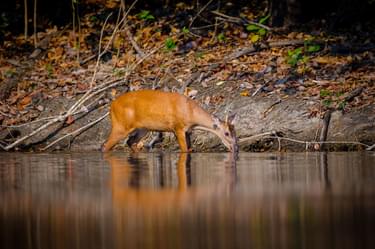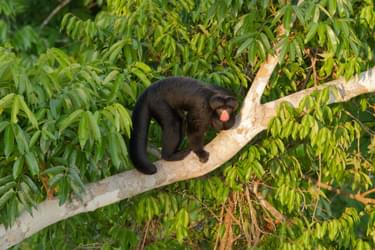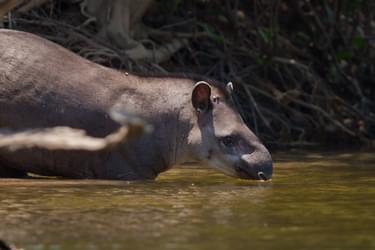











Curious creatures of the Amazon forest, such as the Brazilian Tapir (Tapirus terrestris) - the largest mammal in South America - the White-lipped and the Collared Peccary (Tayassu pecari and Tayassu tajacu) and the Capybara (Hydrochoerus hydrochaeris) can be seen in this area. These large animals feed mainly on plants and roots and are able to move quickly through the forest, due to their relatively short but strong legs and elongated bodies. Tapirs and capybaras are attracted to water and are seen most frequently along the riverbanks, from July to October.
Other much sought mammals include the Giant River Otter (Pteronura brasiliensis) and the Neotropical Otter (Lontra longicaudis), which are excellent swimmers and catchers of fish.

Brazilian Tapir (Tapirus terrestris), the largest mammal in South America.
The forest is also inhabited by seven species of monkey, including the endemic White-whiskered Spider Monkey (Ateles marginatus), Feline Night Monkey (Aotus infulatus), Tufted Capuchin (Sapajus apella), Spix's Red-handed Howler (Alouatta discolor), White-nosed Saki (Chiropotes albinasus), the rare Emilia's marmoset (Mico emiliae) and Dusky Titi Monkey (Plecturocebus moloch). Of these, The Capuchin Monkeys, Spider Monkeys, Howler Monkeys and Saki are commonly sighted.

The White-whiskered Spider Monkey is a symbol of the Cristalino region.
Other, less commonly sighted species include the Collared Anteater (Tamandua tetradactyla), Giant Anteater (Myrmecophaga tridactyla), Tayra (Eira barbara) and shy Three-toed and Two-toed Sloths (Bradypus variegatus and Choloepus didactylus). Meanwhile, rare sightings of a Jaguar or Black Panther (both variations of Panthera onca), Puma (Puma concolor) or Ocelot (Leopardus pardalis) occur perhaps once or twice a year.

Sighting of an Ocelot (Leopardus pardalis).
In spite of the tremendous biodiversity, it is important to bear in mind that spotting animals in the Amazon forest is more challenging than in the more open Cerrado and Pantanal biomes, because the vegetation is tall and dense. Moreover, due to the greater complexity of the ecosystem, many species have a lower population density. On the other hand, the reward is extremely gratifying. Encounters with endemic and specialist species are frequent and there is considerable variety in the species being observed, thus ensuring that the Cristalino Lodge will never cease to entertain and impress the observant visitor.
Furthermore, the Cristalino Lodge adheres to the rules of responsible tourism by the WTTC, not feeding animals or interfering with their natural habitat, so that one can be sure that the sightings of the fauna are truly in accordance with their natural behavior.
Take a look at our collection of wildlife photos.
